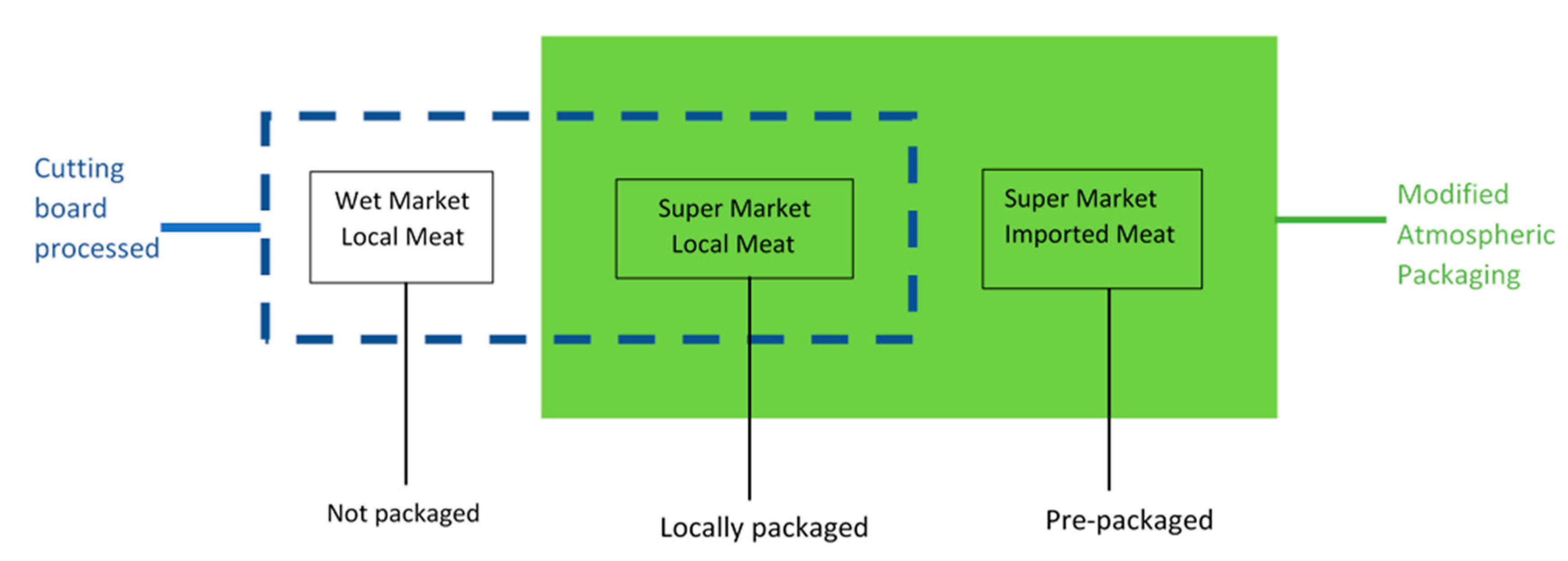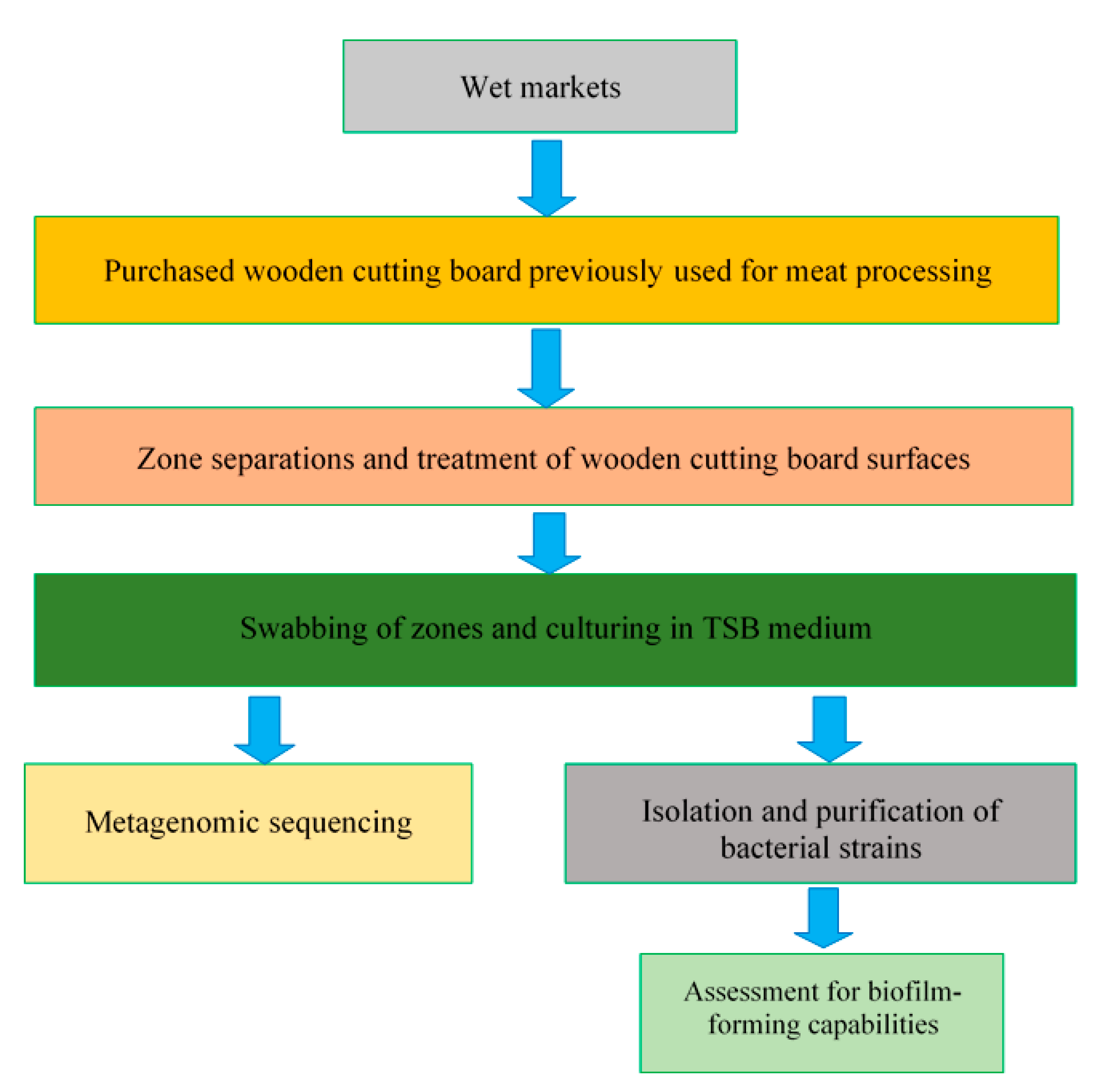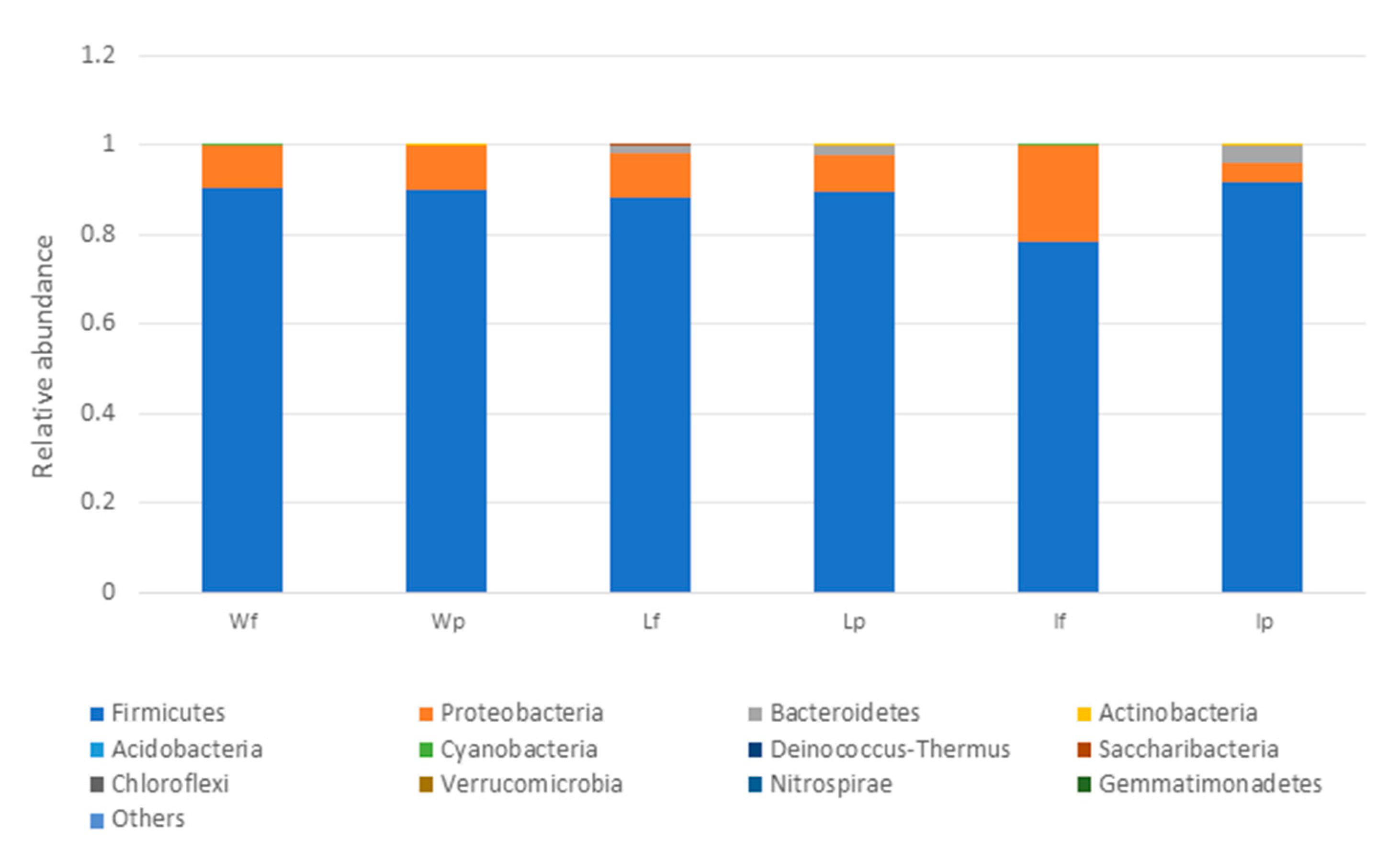Insights into the Microbiological Safety of Wooden Cutting Boards Used for Meat Processing in Hong Kong’s Wet Markets: A Focus on Food-Contact Surfaces, Cross-Contamination and the Efficacy of Traditional Hygiene Practices
Abstract
1. Introduction
2. Materials and Methods
2.1. Purchased Wooden Cutting Board and Swine Raw Samples
2.2. Sampling from the Wooden Cutting Board
2.3. Processing of Meat Samples on the Wooden Cutting Board
2.4. DNA Extraction and 16S Metagenomic Sequencing
2.5. Isolate Identification Via 16S rRNA Sequencing
2.6. Biofilm Screening of Identified Bacterial Isolates
3. Results
3.1. Quantification of MicroorGanisms Found on the Wooden Cutting Board and in Meat Samples
3.2. Microbial Community Profile on the Wooden Cutting Board Surfaces
3.3. Microbial Community Profile in Meat Samples
3.4. Biofilm Assessment of Identified Bacterial Isolates
4. Discussion
4.1. The Influence of Traditional Cleaning Practices on the Wooden Cutting Board
4.2. Microbial Community Profile in Meat Samples
4.3. The Biofilm-Forming Capability of the Isolated Bacterial Strains
5. Conclusions
Supplementary Materials
Author Contributions
Funding
Acknowledgments
Conflicts of Interest
References
- Cheung, E. Link Reit Insists Refurbished Wet Markets Attract More Shoppers, Amid Calls for Lower Rents and Food Prices. Available online: https://www.scmp.com/news/hong-kong/economy/article/2000776/link-reit-insists-refurbished-wet-markets-attract-more (accessed on 10 October 2019).
- Soon, J.M. Rapid Food Hygiene Inspection Tool (RFHiT) to assess hygiene conformance index (CI) of street food vendors. LWT Food Sci. Technol. 2019, 113, 108304. [Google Scholar] [CrossRef]
- Chan, J.-W.; Yuan, S.; Kok, K.-H.; To, K.-W.; Chu, H.; Yang, J.; Xing, F.; Liu, J.; Yip, C.C.-Y.; Poon, R.W.-S.; et al. A familial cluster of pneumonia associated with the 2019 novel coronavirus indicating person-to-person transmission: a study of a family cluster. Lancet 2020, 395, 514–523. [Google Scholar] [CrossRef]
- Lo, M.; Ngan, W.; Tsun, S.; Hsing, H.; Lau, K.; Hung, H.; Chan, S.; Lai, Y.; Yao, Y.; Pu, Y. A field study into Hong Kong’s wet markets: raised questions into the hygienic maintenance of meat contact surfaces and the dissemination of microorganisms associated with nosocomial infections. Front. Microbiol. 2019, 10, 2618. [Google Scholar] [CrossRef] [PubMed]
- Aviat, F.; Gerhards, C.; Rodriguez-Jerez, J.; Michel, V.; Bayon, I.L.; Ismail, R.; Federighi, M. Microbial Safety of Wood in Contact with Food: A Review. Comp. Rev. Food Sc.Food Saf. 2016, 15, 491–505. [Google Scholar] [CrossRef]
- Dantas, S.; Rossi, B.; Bonsaglia, E.; Castilho, I.; Hernandes, R.; Fernandes, A.; Rall, V. Cross-Contamination and Biofilm Formation by Salmonella enterica Serovar Enteritidis on Various Cutting Boards. Foodborne Pathog. Dis. 2018, 15, 81–85. [Google Scholar] [CrossRef]
- Kharel, N.; Palni, U.; Tamang, J. Microbiological assessment of ethnic street foods of the Himalayas. J. Ethnic Foods 2016, 3, 235–241. [Google Scholar] [CrossRef]
- Abrishami, S.; Tall, B.; Bruursema, T.; Epstein, P.; Shah, D. Bacterial adherence and viability on cutting board surfaces. J. Food Saf. 1994, 14, 153–172. [Google Scholar] [CrossRef]
- Abdul-Mutalib, N.A.; Amin Nordin, S.; Osman, M.; Ishida, N.; Tashiro, K.; Sakai, K.; Tashiro, Y.; Maeda, T.; Shirai, Y. Pyrosequencing analysis of microbial community and food-borne bacteria on restaurant cutting boards collected in Seri Kembangan, Malaysia, and their correlation with grades of food premises. Int. J. Food Microbiol. 2015, 200, 57–65. [Google Scholar] [CrossRef]
- Engelund, E.T.; Thygesen, L.G.; Svensson, S.; Hill, C.A.S. A critical discussion of the physics of wood–water interactions. Wood Sci. Technol. 2013, 47, 141–161. [Google Scholar] [CrossRef]
- An, Y.H.; Friedman, R.J. Concise review of mechanisms of bacterial adhesion to biomaterial surfaces. J. Biomed Mater Res. 1998, 43, 338–348. [Google Scholar] [CrossRef]
- Carpentier, B. Sanitary quality of meat chopping board surfaces: A bibliographical study. Food Microbiol. 1997, 14, 31–37. [Google Scholar] [CrossRef]
- Centre for Food Safety. Available online: https://www.cfs.gov.hk/english/faq/faq_01.html (accessed on 10 October 2019).
- Apanga, S.; Addah, J.; Sey, D. Food Safety Knowledge and Practice of Street Food Vendors in Rural Northern Ghana. Food Public Health 2014, 4, 99–103. [Google Scholar]
- Azanza, P.; Corazon, F.; Gatc, M. Food safety knowledge and practices of street food vendors in a Philippines university campus. Int. J. Food Sci. Nutr. 2000, 51, 235–246. [Google Scholar] [PubMed]
- Ma, L.H.; Chen, H.; Yan, H.Z.; Wu, L.F.; Zhang, W.B. Food safety knowledge, attitudes, and behavior of street food vendors and consumers in Handan, a third tier city in China. BMC Public Health 2019, 19. [Google Scholar] [CrossRef] [PubMed]
- Turner, S.; Pryer, K.; Miao, V.; Palmer, J. Investigating deep phylogenetic 565 relationships among cyanobacteria and plastids by small subunit rRNA sequence analysis. J. Eukaryot. Microbiol. 1999, 531, 327–338. [Google Scholar] [CrossRef]
- Magoč, T.; Salzberg, S.L.J.B. FLASH: Fast length adjustment of short reads to improve genome assemblies. Bioinformatics 2011, 27, 2957–2963. [Google Scholar] [CrossRef]
- Bokulich, N.; Subramanian, S.; Faith, J.; Gevers, D.; Gordon, J.; Knight, R.; Mills, D.; Caporaso, J. Quality-filtering vastly improves diversity estimates from Illumina amplicon sequencing. Nature Methods 2013, 10, 57–59. [Google Scholar] [CrossRef]
- Caporaso, J.; Kuczynski, J.; Stombaugh, J.; Bittinger, K.; Bushman, F.; Costello, E.; Fierer, N.; Pena, A.; Goodrich, J.; Gordon, J. QIIME allows analysis of high-throughput community sequencing data. Nat. Methods 2010, 7, 335. [Google Scholar] [CrossRef]
- Edgar, R.; Haas, B.; Clemente, J.; Quince, C.; Knight, R. UCHIME improves sensitivity and speed of chimera detection. Bioinformatics 2011, 27, 2194–2200. [Google Scholar] [CrossRef]
- Edgar, R. UPARSE: Highly accurate OTU sequences from microbial amplicon reads. Nat. Methods 2013, 10, 996. [Google Scholar] [CrossRef]
- DeSantis, T.; Hugenholtz, P.; Larsen, N.; Rojas, M.; Brodie, E.; Keller, K.; Huber, T.; Dalevi, D.; Hu, P.; Andersen, G. Greengenes, a chimera-checked 16S rRNA gene database and workbench compatible with ARB. Appl. Environ. Microbiol. 2006, 72, 5069–5072. [Google Scholar] [CrossRef] [PubMed]
- Wang, Q.; Garrity, G.; Tiedje, J.; Cole, J. Naive Bayesian classifier for rapid assignment of rRNA sequences into the new bacterial taxonomy. Appl. Environ. Microbiol. 2007, 73, 5261–5267. [Google Scholar] [CrossRef] [PubMed]
- Fusco, V.; Quero, G.; Cho, G.; Kabisch, J.; Meske, D.; Neve, H.; Bockelmann, W.; Franz, C. The genus Weissella: Taxonomy, ecology and biotechnological potential. Front. Microbiol. 2015, 6, 155. [Google Scholar] [CrossRef] [PubMed]
- O’Toole, G. Microtiter Dish Biofilm Formation Assay. J. Vis. Exp. 2011, 47, 2437. [Google Scholar] [CrossRef] [PubMed]
- Lambrechts, A.; Human, I.; Doughari, J.; Lues, J. Bacterial contamination of the hands of food handlers as indicator of hand washing efficacy in some convenient food industries in South Africa. Pakistan J. Med. Sci. 2014, 30, 755. [Google Scholar]
- Rinninella, E.; Raoul, P.; Cintoni, M.; Franceschi, F.; Miggiano, G.; Gasbarrini, A.; Mele, M. What is the Healthy Gut Microbiota Composition? A Changing Ecosystem across Age, Environment, Diet, and Diseases. Microorganisms 2019, 7, 14. [Google Scholar] [CrossRef]
- Chao, C.; Lai, C.; Huang, J. Lactococcus garvieae peritoneal dialysis peritonitis. Perit. Dial. Int. 2013, 33, 100–101. [Google Scholar] [CrossRef]
- Ezekiel, C.; Ayeni, K.; Ezeokoli, O.; Sulyok, M.; van Wyk, D.; Oyedele, O.; Akinyemi, O.; Chibuzor-Onyema, I.; Adeleke, R.; Nwangburuka, C.; et al. High-Throughput Sequence Analyses of Bacterial Communities and Multi-Mycotoxin Profiling During Processing of Different Formulations of Kunu, a Traditional Fermented Beverage. Front. Microbiol. 2019, 9, 3282. [Google Scholar] [CrossRef]
- Ahmed, R.; Siddiqui, K.; Arman, M.; Ahmed, N. Characterization of high molecular weight dextran produced by Weissella cibaria CMGDEX3. Carbohydr. Polym. 2012, 90, 441–446. [Google Scholar] [CrossRef]
- Amari, M.; Arango, L.; Gabriel, V.; Robert, H.; Morel, S.; Moulis, C.; Gabriel, B.; Remaud-Simeon, M.; Fontagné-Faucher, C. Characterization of a novel dextransucrase from Weissella confusa isolated from sourdough. Appl. Microbiol. Biotechnol. 2013, 97, 5413–5422. [Google Scholar] [CrossRef]
- Mukhopadhyay, B.; Mitra, S.; Kazi, T.; Mandal, S.; Biswas, S. Draft genome sequence of cold-tolerant Kurthia gibsonii B83, isolated from spinach leaf. Microbiol. Res. Ann. 2019, 8, e01480-18. [Google Scholar] [CrossRef] [PubMed]
- Ruan, Z.; Wang, Y.; Song, J.; Jiang, S.; Wang, H.; Li, Y.; Zhao, B.; Jing, B.; Zhao, B. Kurthia huakuii sp. nov., isolated from biogas slurry, and emended description of the genus Kurthia. Int. J. Syst. Evol. Microbiol. 2013, 64, 518–521. [Google Scholar] [CrossRef] [PubMed]
- Kövesdi, V.; Stercz, B.; Ongrádi, J. Kurthia gibsonii as a sexually transmitted zoonosis: From a neglected condition during World War II to a recent warning for sexually transmitted disease units. Indian J. Sex. Trans. Dis. AIDS 2016, 37, 68–71. [Google Scholar]
- Ongrádi, J.; Stercz, B.; Kövesdi, V.; Nagy, K.; Chatlynne, L. Isolation of Kurthia gibsonii from non-gonorrheal urethritis: Implications for the pathomechanism upon surveying the literature. Acta Microbiol. Immunol. Hung. 2014, 61, 79–87. [Google Scholar] [CrossRef]
- Bennett, S.; Walsh, K.; Gould, L. Foodborne Disease Outbreaks Caused by Bacillus cereus, Clostridium perfringens, and Staphylococcus aureus–United States, 1998–2008. Clin. Infect. Dis. 2013, 57, 425–433. [Google Scholar] [CrossRef]
- Jarvis, K.; Daquigan, N.; White, J.; Morin, P.; Howard, L.; Manetas, J.; Ottesen, A.; Ramachandran, P.; Grim, C. Microbiomes Associated with Foods from Plant and Animal Sources. Front. Microbiol. 2018, 9, 2540. [Google Scholar] [CrossRef]
- Raimondi, S.; Luciani, R.; Sirangelo, T.; Amaretti, A.; Leonardi, A.; Ulrici, A.; Foca, G.; D’Auria, G.; Moya, A.; Zuliani, V.; et al. Microbiota of sliced cooked ham packaged in modified atmosphere throughout the shelf life. Int. J. Food Microbiol. 2019, 289, 200–208. [Google Scholar] [CrossRef]
- Filippidou, S.; Wunderlin, T.; Junier, T.; Jeanneret, N.; Dorador, C.; Molina, V.; Johnson, D.; Junier, P. A Combination of Extreme Environmental Conditions Favor the Prevalence of Endospore-Forming Firmicutes. Front. Microbiol. 2016, 7, 1707. [Google Scholar] [CrossRef]
- Raymond-Bouchard, I.; Chourey, K.; Altshuler, I.; Iyer, R.; Hettich, R.; Whyte, L. Mechanisms of subzero growth in the cryophile Planococcus halocryophilus determined through proteomic analysis. Environ. Microbiol. 2017, 19, 4460–4479. [Google Scholar] [CrossRef]
- Bell, E.; Blake, L.; Sherry, A.; Head, I.; Hubert, C. Distribution of thermophilic endospores in a temperate estuary indicate that dispersal history structures sediment microbial communities. Env. Microbiol. 2018, 20, 1134–1147. [Google Scholar] [CrossRef]
- de Rezende, J.; Kjeldsen, K.; Hubert, C.; Finster, K.; Loy, A.; Jørgensen, B. Dispersal of thermophilic Desulfotomaculum endospores into Baltic Sea sediments over thousands of years. ISME J. 2013, 7, 72–84. [Google Scholar] [CrossRef] [PubMed]
- Müller, A.; de Rezende, J.; Hubert, C.; Kjeldsen, K.; Lagkouvardos, I.; Berry, D.; Jørgensen, B.; Loy, A. Endospores of thermophilic bacteria as tracers of microbial dispersal by ocean currents. ISME J. 2014, 8, 1153–1165. [Google Scholar] [CrossRef] [PubMed]
- Flórez, A.; Mayo, B. The Plasmid Complement of the Cheese Isolate Lactococcus garvieae IPLA 31405 Revealed Adaptation to the Dairy Environment. PLoS ONE 2015, 10, e0126101. [Google Scholar] [CrossRef] [PubMed]
- Jang, J.; Kim, B.; Lee, J.; Kim, J.; Jeong, G.; Han, H. Identification of Weissella species by the genus-specific amplified ribosomal DNA restriction analysis. FEMS Microbiol. Lett. 2002, 212, 29–34. [Google Scholar] [CrossRef]
- Ruiz Rodríguez, L.; Mohamed, F.; Bleckwedel, J.; Medina, R.; De Vuyst, L.; Hebert, E.; Mozzi, F. Diversity and Functional Properties of Lactic Acid Bacteria Isolated from Wild Fruits and Flowers Present in Northern Argentina. Front. Microbiol. 2019, 10, 1091. [Google Scholar] [CrossRef]
- Farman, M.; Yasir, M.; Al-Hindi, R.; Farraj, S.; Jiman-Fatani, A.; Alawi, M.; Azhar, E.; Control, I. Genomic analysis of multidrug-resistant clinical Enterococcus faecalis isolates for antimicrobial resistance genes and virulence factors from the western region of Saudi Arabia. J. Antimicrob. Resist. 2019, 8, 55. [Google Scholar] [CrossRef]
- Kau, A.; Martin, S.; Lyon, W.; Hayes, E.; Caparon, M.; Hultgren, S. Enterococcus faecalis tropism for the kidneys in the urinary tract of C57BL/6J mice. Infect. Immun. 2005, 73, 2461–2468. [Google Scholar] [CrossRef]
- Liu, N.; Nou, X.; Bauchan, G.; Murphy, C.; Lefcourt, A.; Shelton, D.; Lo, Y. Effects of environmental parameters on the dual-species biofilms formed by Escherichia coli O157: H7 and Ralstonia insidiosa, a strong biofilm producer isolated from a fresh-cut produce processing plant. J. Food Prot. 2015, 78, 121–127. [Google Scholar] [CrossRef]
- Alvarez-Ordóñez, A.; Coughlan, L.; Briandet, R.; Cotter, P. Biofilms in food processing environments: challenges and opportunities. Ann. Rev. Food Sci. 2019, 10, 173–195. [Google Scholar] [CrossRef]
- Røder, H.L.; Raghupathi, P.K.; Herschend, J.; Brejnrod, A.; Knøchel, S.; Sørensen, S.; Burmølle, M. Interspecies interactions result in enhanced biofilm formation by co-cultures of bacteria isolated from a food processing environment. Food Microbiol. 2015, 51, 18–24. [Google Scholar] [CrossRef]
- Galie, S.; Garcia-Gutierrez, C.; Miguelez, E.; Villar, C.; Lombo, F. Biofilms in the food industry: Health aspects and control methods. Front. Microbiol. 2018, 9, 898. [Google Scholar] [CrossRef] [PubMed]
- Johansen, M.; Cresswell, T.; Davis, J.; Howard, D.; Howell, N.; Prentice, E. Biofilm-enhanced adsorption of strong and weak cations onto different microplastic sample types: Use of spectroscopy, microscopy and radiotracer methods. Water Res. 2019, 158, 392–400. [Google Scholar] [CrossRef] [PubMed]
- Lim, E.; Lee, J.; Kim, J.-S.; Koo, O. Isolation of indigenous bacteria from a cafeteria kitchen and their biofilm formation and disinfectant susceptibility. LWT Food Sci. Technol. 2017, 77, 376–382. [Google Scholar] [CrossRef]
- Weber, M.; Liedtke, J.; Plattes, S.; Lipski, A. Bacterial community composition of biofilms in milking machines of two dairy farms assessed by a combination of culture-dependent and–independent methods. PLoS ONE 2019, 14, e0222238. [Google Scholar] [CrossRef] [PubMed]
- Sharma, M.; Anand, S. Characterization of constitutive microflora of biofilms in dairy processing lines. Food Microbiol. 2002, 19, 627–636. [Google Scholar] [CrossRef]
- Zhao, S.; Lin, Q.; Ran, J.; Musa, S.; Yang, G.; Wang, W.; Lou, Y.; Gao, D.; Yang, L.; He, D. Preliminary estimation of the basic reproduction number of novel coronavirus (2019-nCoV) in China, from 2019 to 2020: A data-driven analysis in the early phase of the outbreak. Int. J. Infect. Dis. 2020, 92, 214–217. [Google Scholar] [CrossRef]
- Xu, X.-W.; Wu, X.-X.; Jiang, X.-G.; Xu, K.-J.; Ying, L.-J.; Ma, C.-L.; Li, S.-B.; Wang, H.-Y.; Zhang, S.; Gao, H.-N. Clinical findings in a group of patients infected with the 2019 novel coronavirus (SARS-Cov-2) outside of Wuhan, China: retrospective case series. BMJ 2020, 368, m606. [Google Scholar] [CrossRef]







| Sample | Colony Count |
|---|---|
| Fresh meat from the wet market | 1.90 × 104 ± 2.25 × 104 a |
| Processed meat from the wet market | 1.85 × 104 ± 6.17 × 103 a |
| Fresh meat from the local supermarket | 9.31 × 102 ± 7.44 × 102 a |
| Processed meat from the local supermarket | 9.02 × 103 ± 8.42 × 103 a |
| Imported fresh meat | 8.1 × 101 ± 6.3 × 101 a |
| Imported processed meat | 1.98 × 104 ± 2.0 × 103 a |
| Purchased wooden cutting board | 2.26 × 106 ± 5.37 × 105 b |
© 2020 by the authors. Licensee MDPI, Basel, Switzerland. This article is an open access article distributed under the terms and conditions of the Creative Commons Attribution (CC BY) license (http://creativecommons.org/licenses/by/4.0/).
Share and Cite
Sekoai, P.T.; Feng, S.; Zhou, W.; Ngan, W.Y.; Pu, Y.; Yao, Y.; Pan, J.; Habimana, O. Insights into the Microbiological Safety of Wooden Cutting Boards Used for Meat Processing in Hong Kong’s Wet Markets: A Focus on Food-Contact Surfaces, Cross-Contamination and the Efficacy of Traditional Hygiene Practices. Microorganisms 2020, 8, 579. https://doi.org/10.3390/microorganisms8040579
Sekoai PT, Feng S, Zhou W, Ngan WY, Pu Y, Yao Y, Pan J, Habimana O. Insights into the Microbiological Safety of Wooden Cutting Boards Used for Meat Processing in Hong Kong’s Wet Markets: A Focus on Food-Contact Surfaces, Cross-Contamination and the Efficacy of Traditional Hygiene Practices. Microorganisms. 2020; 8(4):579. https://doi.org/10.3390/microorganisms8040579
Chicago/Turabian StyleSekoai, Patrick T., Shiqi Feng, Wenwen Zhou, Wing Y. Ngan, Yang Pu, Yuan Yao, Jie Pan, and Olivier Habimana. 2020. "Insights into the Microbiological Safety of Wooden Cutting Boards Used for Meat Processing in Hong Kong’s Wet Markets: A Focus on Food-Contact Surfaces, Cross-Contamination and the Efficacy of Traditional Hygiene Practices" Microorganisms 8, no. 4: 579. https://doi.org/10.3390/microorganisms8040579
APA StyleSekoai, P. T., Feng, S., Zhou, W., Ngan, W. Y., Pu, Y., Yao, Y., Pan, J., & Habimana, O. (2020). Insights into the Microbiological Safety of Wooden Cutting Boards Used for Meat Processing in Hong Kong’s Wet Markets: A Focus on Food-Contact Surfaces, Cross-Contamination and the Efficacy of Traditional Hygiene Practices. Microorganisms, 8(4), 579. https://doi.org/10.3390/microorganisms8040579






